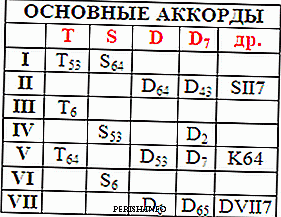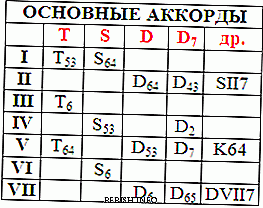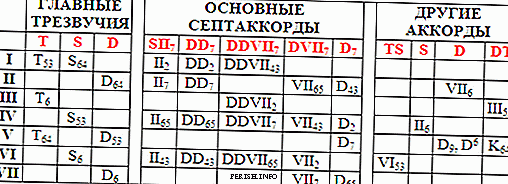
That each time it is painful not to remember on what steps are chords being built, get in your notebook notebooks, cheat sheets. Solfeggio tablesBy the way, they can be used with the same success on harmony, you can print and paste or rewrite it in your musical notebook on the subject.
It is very convenient to use such labels when composing or deciphering any digital sequences and sequences. It is also cool to have such a clue on harmony, when a stupor comes, and you can’t find a suitable chord for harmonization, then everything is right before your eyes - something will definitely work.
I decided to do solfeggio tables in two versions - one more complete (for students of colleges, colleges and universities), the other - simpler (for schoolchildren). Choose the one that suits you.
So, the first option ...
Solfeggio tables for school
 I hope everything is clear. Do not forget that in the harmonic minor the seventh step rises. Keep this in mind when drawing up dominant chords. And here is the second option ...
I hope everything is clear. Do not forget that in the harmonic minor the seventh step rises. Keep this in mind when drawing up dominant chords. And here is the second option ...
College solfegio tables

We see that there are only three columns: in the first, the most elementary are the main triads and their circulation on the steps of the scale; in the second, the main seventh chords are clearly seen, for example, on which steps the double dominant chords are built; The third section contains all sorts of other chords.
A few important notes. Remember, yes, that in major and minor chords are slightly different? Therefore, we do not forget, when it is necessary, to raise the seventh step in the harmonic minor, or to lower the sixth in the harmonic major, to get, for example, a reduced introductory seventh chord.
Remember that a double dominant is always associated with an increase in stage IV? Fine! I think you know and remember. I did not make all these little things in the column with the steps.
More about other chords
Perhaps, I forgot to bring here another kind - a double dominant in the form of a triad and sekstakkorda, which can also be used to harmonize and compose sequences. Well, add it yourself, if necessary - do not worry. Still, the double dominant chords in the middle of the construction are not so often used, and it is better to use the seventh chords before the caddish.
Sestakkord II stage - II6 it is used quite often, especially in pre-advance constructions, and in this sektakkorda you can double the tone tone (bass).
Sekstakkord VII steps - VII6 used in two cases: 1) to harmonize the turnover T VII6 T6 up and down; 2) to harmonize the melody when it goes up the steps VI, VII, I in the form of a turnover S VII6 T. In this sekstakkorda double bass (tertzovy tone). Remember, yes, that usually bass doesn't double in sextcords? But you two chords (II6 and VII6), in which it is possible and even necessary to double the bass. More bass duplications are needed in tonic sekstakkord when resolving introductory seventh chords in them.
Third Step Triad - III53 it is used to harmonize the VII stage in the melody, but only if it goes not up to the first step, but downwards - to the sixth. This happens, for example, in Phrygian revolutions. Sometimes, however, use and passing a turn with the third stage - III D43 T.
Dominant nonaccord (D9) and dominant with sixth (D6) - amazing beauty of consonance, you probably know everything about them. In the dominant with the sixth - the sixth is taken instead of the fifth. In nonaccord for the sake of nona, the fourth tone is skipped in the four voices.
Triad VI Stage - often used in interrupted turns after D7. When permitting a dominant septcord into it, doubling of the third will be necessary.
Everything! How cruel is your fate, because now you no longer suffer, remembering at what levels the chords are built. You now have tables for solfege. Like this!))))

Leave Your Comment